IPSec - Connexion entre un pare-feu PIX et un client VPN Cisco avec caractères génériques, clés pré-partagées, mode configuration avec authentification étendue
Contenu
Introduction
Cet exemple de configuration montre comment connecter un client VPN à un pare-feu PIX à l'aide de caractères génériques, mode-config, la commande sysopt connection permit-ipsec et l'authentification étendue (Xauth).
Afin de voir la configuration TACACS+ et RADIUS pour PIX 6.3 et versions ultérieures, référez-vous à TACACS+ et RADIUS pour PIX 6.3 et PIX/ASA 7.x Exemple de configuration.
Le client VPN prend en charge la norme AES (Advanced Encryption Standard) en tant qu'algorithme de chiffrement dans Cisco VPN Client version 3.6.1 et ultérieure et avec PIX Firewall 6.3. Le client VPN prend en charge des tailles de clés de 128 bits et 256 bits uniquement. Pour plus d'informations sur la configuration d'AES, référez-vous à Comment configurer le client VPN Cisco sur PIX avec AES.
Référez-vous à Exemple de configuration d'authentification RADIUS PIX/ASA 7.x et Cisco VPN Client 4.x pour Windows avec Microsoft Windows 2003 IAS pour configurer la connexion VPN d'accès à distance entre un client VPN Cisco (4.x pour Windows) et le dispositif de sécurité de la gamme PIX 500 7.x à l'aide d'un serveur RADIUS Microsoft Windows 2000000000000000000000000000000000000000000000000000000000000000000000000000
Conditions préalables
Conditions requises
Aucune spécification déterminée n'est requise pour ce document.
Components Used
Les informations contenues dans ce document sont basées sur les versions de matériel et de logiciel suivantes :
-
Client VPN Cisco 4.x Ce produit possède des fonctionnalités VPN avancées, contrairement au client VPN sécurisé Cisco 1.x.
-
PIX Firewall 515E version 6.3(3).
Remarque : La technologie de chiffrement est soumise à des contrôles d'exportation. Il est de votre responsabilité de connaître la loi relative à l'exportation des technologies de chiffrement. Pour de plus amples renseignements, consultez le site Web ![]() du Bureau de l'administration des exportations. Si vous avez des questions concernant le contrôle des exportations, veuillez envoyer un courriel à export@cisco.com.
du Bureau de l'administration des exportations. Si vous avez des questions concernant le contrôle des exportations, veuillez envoyer un courriel à export@cisco.com.
The information in this document was created from the devices in a specific lab environment. All of the devices used in this document started with a cleared (default) configuration. If your network is live, make sure that you understand the potential impact of any command.
Conventions
Pour plus d'informations sur les conventions utilisées dans ce document, reportez-vous à Conventions relatives aux conseils techniques Cisco.
Informations générales
La commande sysopt connection permit-ipsec autorise implicitement tout paquet provenant d'un tunnel IPsec à contourner la vérification d'une liste d'accès associée, d'un conduit ou d'une commande access-group pour les connexions IPsec. Xauth authentifie l'utilisateur IPsec sur un serveur TACACS+ ou RADIUS externe. En plus de la clé pré-partagée générique, l'utilisateur doit fournir un nom d'utilisateur/mot de passe.
Un utilisateur ayant un client VPN reçoit une adresse IP de son FAI. Cette adresse est remplacée par une adresse IP du pool d'adresses IP du PIX. L'utilisateur a accès à tout ce qui se trouve à l'intérieur du pare-feu, y compris les réseaux. Les utilisateurs qui n'exécutent pas le client VPN peuvent se connecter uniquement au serveur Web à l'aide de l'adresse externe fournie par l'affectation statique.
Configuration
Cette section vous fournit des informations pour configurer les fonctionnalités décrites dans ce document.
Remarque : Utilisez l’outil de recherche de commandes (clients inscrits seulement) pour en savoir plus sur les commandes figurant dans le présent document.
Diagramme du réseau
Ce document utilise la configuration réseau suivante :
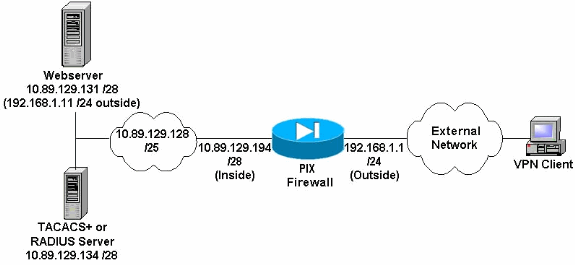
Notes de diagramme de réseau
-
Les hôtes Internet qui accèdent au serveur Web à l’aide de l’adresse IP globale 192.168.1.1 sont authentifiés même si une connexion VPN n’est pas établie. Ce trafic n'est pas chiffré.
-
Les clients VPN peuvent accéder à tous les hôtes du réseau interne (10.89.129.128 /25) une fois leur tunnel IPsec établi. Tout le trafic du client VPN au pare-feu PIX est chiffré. Sans tunnel IPsec, ils ne peuvent accéder au serveur Web que par l'intermédiaire de son adresse IP globale, mais doivent toujours s'authentifier.
-
Les clients VPN proviennent d’Internet et leurs adresses IP ne sont pas connues à l’avance.
Configurations
Ce document utilise les configurations suivantes.
| Configuration PIX 6.3(3) |
|---|
pixfirewall#show run : Saved : PIX Version 6.3(3) interface ethernet0 100full interface ethernet1 100full nameif ethernet0 outside security0 nameif ethernet1 inside security100 enable password 8Ry2YjIyt7RRXU24 encrypted passwd 2KFQnbNIdI.2KYOU encrypted hostname pixfirewall fixup protocol dns maximum-length 512 fixup protocol ftp 21 fixup protocol h323 h225 1720 fixup protocol h323 ras 1718-1719 fixup protocol http 80 fixup protocol rsh 514 fixup protocol rtsp 554 fixup protocol sip 5060 fixup protocol sip udp 5060 fixup protocol skinny 2000 fixup protocol smtp 25 fixup protocol sqlnet 1521 fixup protocol tftp 69 names !--- Do not use Network Address Translation (NAT) for inside-to-pool !--- traffic. This should not go through NAT. access-list 101 permit ip 10.89.129.128 255.255.255.240 10.89.129.192 255.255.255.240 !--- Permits Internet Control Message Protocol (ICMP) !--- Transmission Control Protocol (TCP) and User Datagram Protocol (UDP) !--- traffic from any host on the Internet (non-VPN) to the web server. access-list 120 permit icmp any host 10.89.129.131 access-list 120 permit tcp any host 10.89.129.131 access-list 120 permit udp any host 10.89.129.131 pager lines 24 mtu outside 1500 mtu inside 1500 ip address outside 192.168.1.1 255.255.255.0 ip address inside 10.89.129.194 255.255.255.240 ip audit info action alarm ip audit attack action alarm !--- Specifies the inside IP address range to be assigned !--- to the VPN Clients. ip local pool VPNpool 10.89.129.200-10.89.129.204 no failover failover timeout 0:00:00 failover poll 15 no failover ip address outside no failover ip address inside pdm history enable arp timeout 14400 !--- Defines a pool of global addresses to be used by NAT. global (outside) 1 192.168.1.6-192.168.1.10 nat (inside) 0 access-list 101 nat (inside) 1 0.0.0.0 0.0.0.0 0 0 !--- Specifies which outside IP address to apply to the web server. static (inside,outside) 192.168.1.11 10.89.129.131 netmask 255.255.255.255 0 0 !--- Apply ACL 120 to the outside interface in the inbound direction. access-group 120 in interface outside !--- Defines a default route for the PIX. route outside 0.0.0.0 0.0.0.0 192.168.1.3 1 !--- Defines a route for traffic within the PIX's !--- subnet to reach other inside hosts. route inside 10.89.129.128 255.255.255.128 10.89.129.193 1 timeout xlate 3:00:00 timeout conn 1:00:00 half-closed 0:10:00 udp 0:02:00 rpc 0:10:00 h225 1:00:00 timeout h323 0:05:00 mgcp 0:05:00 sip 0:30:00 sip_media 0:02:00 timeout uauth 0:05:00 absolute aaa-server TACACS+ protocol tacacs+ aaa-server RADIUS protocol radius aaa-server LOCAL protocol local !--- Authentication, authorization, and accounting (AAA) statements !--- for authentication. !--- Use either of these statements to define the protocol of the group AuthInbound. !--- You cannot use both. aaa-server AuthInbound protocol tacacs+ !--- OR aaa-server AuthInbound protocol radius !--- After you define the protocol of the group AuthInbound, define !--- a server of the same type. !--- In this case we specify the TACACS+ server and key of "secretkey". aaa-server AuthInbound (inside) host 10.89.129.134 secretkey timeout 10 !--- Authenticate HTTP, FTP, and Telnet traffic to the web server. aaa authentication include http outside 10.89.129.131 255.255.255.255 0.0.0.0 0.0.0.0 AuthInbound aaa authentication include ftp outside 10.89.129.131 255.255.255.255 0.0.0.0 0.0.0.0 AuthInbound aaa authentication include telnet outside 10.89.129.131 255.255.255.255 0.0.0.0 0.0.0.0 AuthInbound no snmp-server location no snmp-server contact snmp-server community public no snmp-server enable traps floodguard enable !--- Trust IPsec traffic and avoid going through ACLs/NAT. sysopt connection permit-ipsec !--- IPsec and dynamic map configuration. crypto ipsec transform-set myset esp-des esp-md5-hmac crypto dynamic-map dynmap 10 set transform-set myset crypto map mymap 10 ipsec-isakmp dynamic dynmap !--- Assign IP address for VPN 1.1 Clients. crypto map mymap client configuration address initiate crypto map mymap client configuration address respond !--- Use the AAA server for authentication (AuthInbound). crypto map mymap client authentication AuthInbound !--- Apply the IPsec/AAA/ISAKMP configuration to the outside interface. crypto map mymap interface outside isakmp enable outside !--- Pre-shared key for VPN 1.1 Clients. isakmp key ******** address 0.0.0.0 netmask 0.0.0.0 isakmp identity address !--- Assign address from "VPNpool" pool for VPN 1.1 Clients. isakmp client configuration address-pool local VPNpool outside !--- ISAKMP configuration for VPN Client 3.x/4.x. isakmp policy 10 authentication pre-share isakmp policy 10 encryption des isakmp policy 10 hash md5 isakmp policy 10 group 2 isakmp policy 10 lifetime 86400 !--- ISAKMP configuration for VPN Client 1.x. isakmp policy 20 authentication pre-share isakmp policy 20 encryption des isakmp policy 20 hash md5 isakmp policy 20 group 1 isakmp policy 20 lifetime 86400 !--- Assign addresses from "VPNpool" for VPN Client 3.x/4.x. vpngroup vpn3000 address-pool VPNpool vpngroup vpn3000 idle-time 1800 !--- Group password for VPN Client 3.x/4.x (not shown in configuration). vpngroup vpn3000 password ******** telnet timeout 5 ssh timeout 5 console timeout 0 terminal width 80 Cryptochecksum:ba54c063d94989cbd79076955dbfeefc : end pixfirewall# |
Configuration du client VPN 4.0.5
Exécutez ces étapes pour configurer le client VPN 4.0.5.
-
Sélectionnez Démarrer > Programmes > Client VPN Cisco Systems > Client VPN.
-
Cliquez New pour ouvrir la fenêtre Create New VPN Connection Entry.
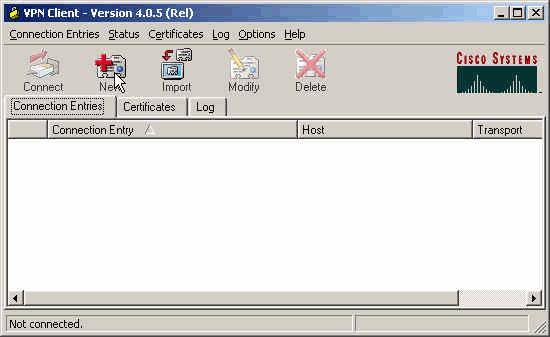
-
Entrez le nom de l'entrée de connexion avec une description. Entrez l'adresse IP externe du pare-feu PIX dans la zone Host. Entrez ensuite le nom du groupe VPN et le mot de passe, puis cliquez sur Save.
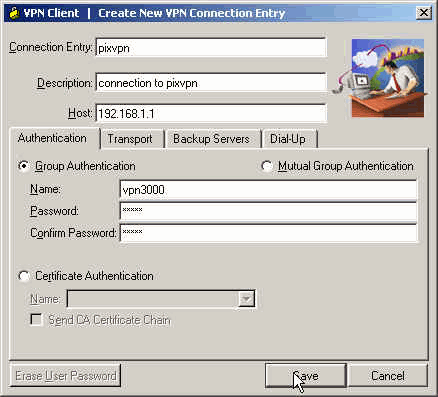
-
Dans la fenêtre principale du client VPN, cliquez sur la connexion que vous souhaitez utiliser et cliquez sur le bouton Connect.
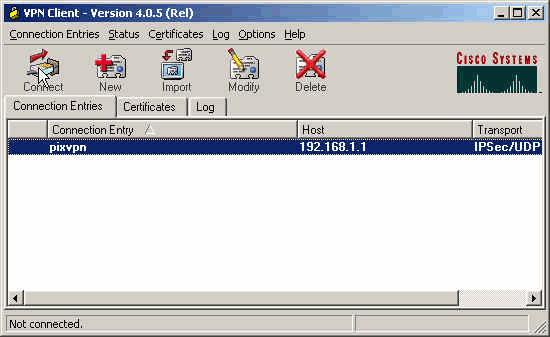
-
Lorsque vous y êtes invité, saisissez le nom d'utilisateur et le mot de passe pour Xauth et cliquez sur OK pour vous connecter au réseau distant.
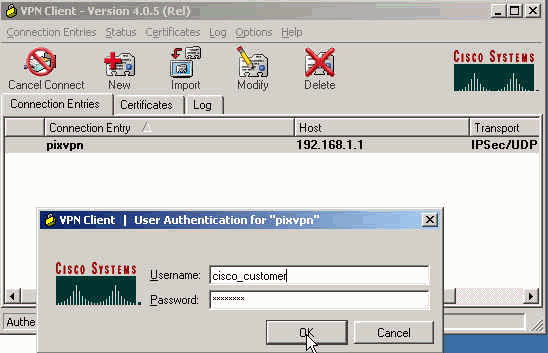
Configuration VPN Client 3.5
Complétez ces étapes pour configurer le client VPN 3.5.
-
Sélectionnez Démarrer > Programmes > Cisco Systems VPN Client > VPN Dialer.
-
Cliquez sur Nouveau pour lancer l'Assistant Nouvelle entrée de connexion.
-
Entrez le nom de votre nouvelle entrée de connexion et cliquez sur Suivant.
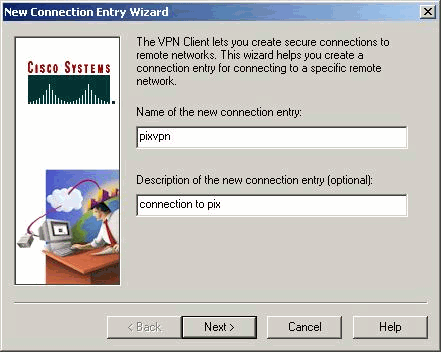
-
Entrez le nom d'hôte ou l'adresse IP du serveur utilisé pour se connecter au serveur distant et cliquez sur Suivant.
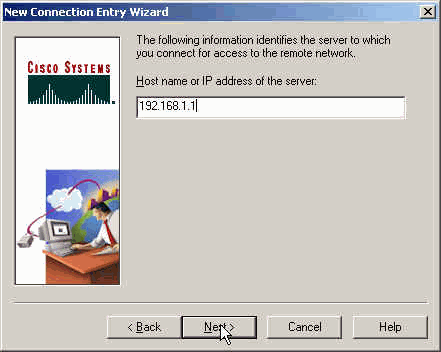
-
Sélectionnez Group Access Information et saisissez le nom et le mot de passe utilisés pour authentifier votre accès au serveur distant. Cliquez sur Next (Suivant).
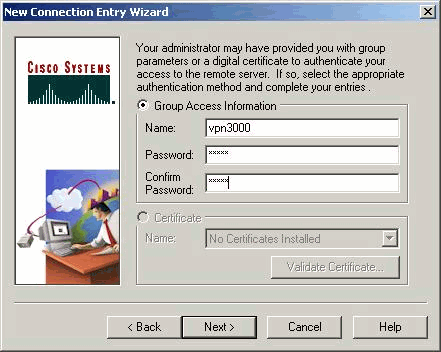
-
Cliquez sur Terminer pour enregistrer la nouvelle entrée.

-
Sélectionnez l'entrée de connexion dans le numéroteur et cliquez sur Connect.
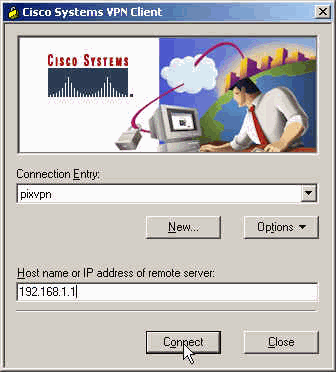
-
Lorsque vous y êtes invité, saisissez le nom d'utilisateur et le mot de passe pour Xauth et cliquez sur OK pour vous connecter au réseau distant.
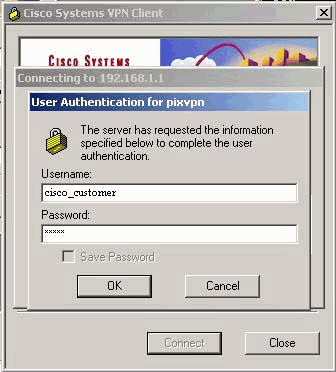
| Configuration VPN Client 1.1 |
|---|
Network Security policy:
1- TACconn
My Identity
Connection security: Secure
Remote Party Identity and addressing
ID Type: IP subnet
10.89.129.128
255.255.255.128
Port all Protocol all
Connect using secure tunnel
ID Type: IP address
192.168.1.1
Pre-shared Key=cisco1234
Authentication (Phase 1)
Proposal 1
Authentication method: pre-shared key
Encryp Alg: DES
Hash Alg: MD5
SA life: Unspecified
Key Group: DH 1
Key exchange (Phase 2)
Proposal 1
Encapsulation ESP
Encrypt Alg: DES
Hash Alg: MD5
Encap: tunnel
SA life: Unspecified
no AH
2- Other Connections
Connection security: Non-secure
Local Network Interface
Name: Any
IP Addr: Any
Port: All |
Ajoutez la gestion des comptes
La syntaxe de la commande à ajouter à la comptabilité est la suivante :
aaa accounting include acctg_service inbound|outbound l_ip l_mask [f_ip f_mask] server_tag
Par exemple, dans la configuration PIX, cette commande est ajoutée :
aaa accounting include any inbound 0.0.0.0 0.0.0.0 0.0.0.0 0.0.0.0 AuthInbound
Remarque : La commande sysopt connection permit-ipsec, et non la commande sysopt ipsec pl-compatible, est nécessaire pour que la comptabilité Xauth fonctionne. La comptabilité Xauth ne fonctionne pas uniquement avec la commande sysopt ipsec pl-compatible. La comptabilité Xauth est valide pour les connexions TCP, pas ICMP ou UDP.
Ce résultat est un exemple d'enregistrements comptables TACACS+ :
07/27/2004 15:17:54 cisco_customer Default Group 10.89.129.200 stop 15 .. 99 1879 .. .. 0x5 .. PIX 10.89.129.194 telnet 07/27/2004 15:17:39 cisco_customer Default Group 10.89.129.200 start .. .. .. .. .. .. 0x5 .. PIX 10.89.129.194 telnet
Vérification
Référez-vous à cette section pour vous assurer du bon fonctionnement de votre configuration.
L'Outil Interpréteur de sortie (clients enregistrés uniquement) (OIT) prend en charge certaines commandes show. Utilisez l'OIT pour afficher une analyse de la sortie de la commande show .
Remarque : Consulter les renseignements importants sur les commandes de débogage avant d’utiliser les commandes de débogage.
Activez Cisco Secure Log Viewer afin de voir les débogages côté client.
-
debug crypto ipsec - Utilisé pour voir les négociations IPsec de la phase 2.
-
debug crypto isakmp - Utilisé pour voir les négociations ISAKMP de la phase 1.
Dépannage
Cette section fournit des informations que vous pouvez utiliser pour dépanner votre configuration. L'exemple de sortie Debug est également affiché.
Dépannage des commandes
L'Outil Interpréteur de sortie (clients enregistrés uniquement) (OIT) prend en charge certaines commandes show. Utilisez l'OIT pour afficher une analyse de la sortie de la commande show .
Remarque : Consulter les renseignements importants sur les commandes de débogage avant d’utiliser les commandes de débogage.
-
debug crypto engine - Utilisé pour déboguer le processus crypto engine.
Exemple de débogage PIX
pixfirewall#show debug
debug crypto ipsec 1
debug crypto isakmp 1
debug crypto engine
debug fover status
tx Off
rx Off
open Off
cable Off
txdmp Off
rxdmp Off
ifc Off
rxip Off
txip Off
get Off
put Off
verify Off
switch Off
fail Off
fmsg Off
Débogues avec VPN Client 4.x
pixfirewall#
crypto_isakmp_process_block: src 192.168.1.2, dest 192.168.1.1
VPN Peer: ISAKMP: Added new peer: ip:192.168.1.2
Total VPN Peers:1
VPN Peer: ISAKMP: Peer ip:192.168.1.2 Ref cnt incremented
to:1 Total VPN Peers:1
OAK_AG exchange
ISAKMP (0): processing SA payload. message ID = 0
ISAKMP (0): Checking ISAKMP transform 1 against priority 10 policy
ISAKMP: encryption 3DES-CBC
ISAKMP: hash SHA
ISAKMP: default group 2
ISAKMP: extended auth pre-share
ISAKMP: life type in seconds
ISAKMP: life duration (VPI) of 0x0 0x20 0xc4 0x9b
ISAKMP (0): atts are not acceptable. Next payload is 3
ISAKMP (0): Checking ISAKMP transform 2 against priority 10 policy
ISAKMP: encryption 3DES-CBC
ISAKMP: hash MD5
ISAKMP: default group 2
ISAKMP: extended auth pre-share
ISAKMP: life type in seconds
ISAKMP: life duration (VPI) of 0x0 0x20 0xc4 0x9b
ISAKMP (0): atts are not acceptable. Next payload is 3
ISAKMP (0): Checking ISAKMP transform 3 against priority 10 policy
ISAKMP: encryption 3DES-CBC
ISAKMP: hash SHA
ISAKMP: default group 2
ISAKMP: auth pre-shared
ISAKMP: life type in seconds
ISAKMP: life duration (VPI) of 0x0 0x20 0xc4 0x9b
ISAKMP (0): atts are not acceptable. Next payload is 3
ISAKMP (0): Checking ISAKMP transform 4 against priority 10 policy
ISAKMP: encryption 3DES-CBC
ISAKMP: hash MD5
ISAKMP: default group 2
ISAKMP: auth pre-share
ISAKMP: life type in seconds
ISAKMP: life duration (VPI) of 0x0 0x20 0xc4 0x9b
ISAKMP (0): atts are not acceptable. Next payload is 3
ISAKMP (0): Checking ISAKMP transform 5 against priority 10 policy
ISAKMP: encryption DES-CBC
ISAKMP: hash SHA
ISAKMP: default group 2
ISAKMP: extended auth pre-share
ISAKMP: life type in seconds
ISAKMP: life duration (VPI) of 0x0 0x20 0xc4 0x9b
ISAKMP (0): atts are not acceptable. Next payload is 3
ISAKMP (0): Checking ISAKMP transform 6 against priority 10 policy
ISAKMP: encryption DES-CBC
ISAKMP: hash MD5
ISAKMP: default group 2
ISAKMP: extended auth pre-share
ISAKMP: life type in seconds
ISAKMP: life duration (VPI) of 0x0 0x20 0xc4 0x9b
ISAKMP (0): atts are acceptable. Next payload is 3
!--- Attributes offered by the VPN Client are accepted by the PIX.
ISAKMP (0): processing KE payload. message ID = 0
ISAKMP (0): processing NONCE payload. message ID = 0
ISAKMP (0): processing ID payload. message ID = 0
ISAKMP (0): processing vendor id payload
ISAKMP (0): processing vendor id payload
ISAKMP (0): remote peer supports dead peer detection
ISAKMP (0): processing vendor id payload
ISAKMP (0): speaking to a Unity client
ISAKMP (0): ID payload
next-payload: 10
type : 1
protocol : 17
port : 500
length : 8
ISAKMP (0) : Total payload length: 12
return status is IKMP_NO_ERROR
crypto_isakmp_process_block: src 192.168.1.2, dest 192.168.1.1 OAK_AG exchange
ISAKMP (0): processing HASH payload. message ID = 0
ISAKMP (0): processing NOTIFY payload 24578 protocol 1
spi 0, message ID = 0
ISAKMP (0): processing notify INITIAL_CONTACT
IPSEC(key_engine): got a queue event...
IPSEC(key_engine_delete_sas): rec'd delete notify from ISAKMP
IPSEC(key_engine_delete_sas): delete all SAs
shared with 192.168.1.2
ISAKMP (0): SA has been authenticated
return status is IKMP_NO_ERROR
ISAKMP/xauth: request attribute XAUTH_TYPE
ISAKMP/xauth: request attribute XAUTH_USER_NAME
ISAKMP/xauth: request attribute XAUTH_USER_PASSWORD
ISAKMP (0:0): initiating peer config to 192.168.1.2.
ID = 1623347510 (0x60c25136) crypto_isakmp_process_block: src 192.168.1.2,
dest 192.168.1.1
ISAKMP_TRANSACTION exchange
ISAKMP (0:0): processing transaction payload
from 192.168.1.2. message ID = 84
ISAKMP: Config payload CFG_REPLY
return status is IKMP_ERR_NO_RETRANS
ISAKMP (0:0): initiating peer config to 192.168.1.2.
ID = 2620656926 (0x9c340d1e) crypto_isakmp_process_block: src 192.168.1.2,
dest 192.168.1.1
ISAKMP_TRANSACTION exchange
ISAKMP (0:0): processing transaction payload
from 192.168.1.2. message ID = 60
ISAKMP: Config payload CFG_ACK
return status is IKMP_NO_ERROR
crypto_isakmp_process_block: src 192.168.1.2, dest 192.168.1.1
ISAKMP_TRANSACTION exchange
ISAKMP (0:0): processing transaction payload
from 192.168.1.2. message ID = 0
ISAKMP: Config payload CFG_REQUEST
ISAKMP (0:0): checking request:
ISAKMP: attribute IP4_ADDRESS (1)
ISAKMP: attribute IP4_NETMASK (2)
ISAKMP: attribute IP4_DNS (3)
ISAKMP: attribute IP4_NBNS (4)
ISAKMP: attribute ADDRESS_EXPIRY (5)
Unsupported Attr: 5
ISAKMP: attribute APPLICATION_VERSION (7)
Unsupported Attr: 7
ISAKMP: attribute UNKNOWN (28672)
Unsupported Attr: 28672
ISAKMP: attribute UNKNOWN (28673)
Unsupported Attr: 28673
ISAKMP: attribute UNKNOWN (28674)
ISAKMP: attribute UNKNOWN (28676)
ISAKMP: attribute UNKNOWN (28679)
Unsupported Attr: 28679
ISAKMP: attribute UNKNOWN (28680)
Unsupported Attr: 28680
ISAKMP: attribute UNKNOWN (28677)
Unsupported Attr: 28677
ISAKMP (0:0): responding to peer config from 192.168.1.2. ID = 177917346
return status is IKMP_NO_ERROR
crypto_isakmp_process_block: src 192.168.1.2, dest 192.168.1.1
OAK_QM exchange
oakley_process_quick_mode:
OAK_QM_IDLE
ISAKMP (0): processing SA payload. message ID = 942875080
ISAKMP : Checking IPSec proposal 1
ISAKMP: transform 1, ESP_3DES
ISAKMP: attributes in transform:
ISAKMP: authenticator is HMAC-MD5
ISAKMP: encaps is 1
ISAKMP: SA life type in seconds
ISAKMP: SA life duration (VPI) of 0x0 0x20 0xc4 0x9b
IPSEC(validate_proposal): transform
proposal (prot 3, trans 3, hmac_alg 1) not supported
ISAKMP (0): atts not acceptable. Next payload is 0
ISAKMP (0): skipping next ANDed proposal (1)
ISAKMP : Checking IPSec proposal 2
ISAKMP: transform 1, ESP_3DES
ISAKMP: attributes in transform:
ISAKMP: authenticator is HMAC-SHA
ISAKMP: encaps is 1
ISAKMP: SA life type in seconds
ISAKMP: SA life duration (VPI) of 0x0 0x20 0xc4 0x9b
IPSEC(validate_proposal): transform
proposal (prot 3, trans 3, hmac_alg 2) not supported
ISAKMP (0): atts not acceptable. Next payload is 0
ISAKMP (0): skipping next ANDed proposal (2)
ISAKMP: Checking IPSec proposal 3
ISAKMP: transform 1, ESP_3DES
ISAKMP: attributes in transform:
ISAKMP: authenticator is HMAC-MD5
ISAKMP: encaps is 1
ISAKMP: SA life type in seconds
ISAKMP: SA life duration (VPI) of 0x0 0x20 0xc4 0x9b
IPSEC(validate_proposal): transform
proposal (prot 3, trans 3, hmac_alg 1) not supported
ISAKMP (0): atts not acceptable. Next payload is 0
ISAKMP: Checking IPSec proposal 4
ISAKMP: transform 1, ESP_3DES
ISAKMP: attributes in transform:
ISAKMP: authenticator is HMAC-SHA
ISAKMP: encaps is 1
ISAKMP: SA life type in seconds
ISAKMP: SA life duration (VPI) of 0x0 0x20 0xc4 0x9b
IPSEC(validate_proposal): transform
proposal (prot 3, trans 3, hmac_alg 2) not supported
ISAKMP (0): atts not acceptable. Next payload is 0
ISAKMP : Checking IPSec proposal 5
ISAKMP: transform 1, ESP_DES
ISAKMP: attributes in transform:
ISAKMP: authenticator is HMAC-MD5
ISAKMP: encaps is 1
ISAKMP: SA life type in seconds
ISAKMP: SA life duration (VPI) of 0x0 0x20 0xc4 0x9b
ISAKMP (0): atts are acceptable.
ISAKMP (0): bad SPI size of 2 octets!
ISAKMP: Checking IPSec proposal 6
ISAKMP: transform 1, ESP_DES
ISAKMP: attributes in transform:
ISAKMP: authenticator is HMAC-SHA
ISAKMP: encaps is 1
ISAKMP: SA life type in seconds
ISAKMP: SA life duration (VPI) of 0x0 0x20 0xc4 0x9b
IPSEC(validate_proposal): transform
proposal (prot 3, trans 2, hmac_alg 2) not supported
ISAKMP (0): atts not acceptable. Next payload is 0
ISAKMP (0): skipping next ANDed proposal (6)
ISAKMP : Checking IPSec proposal 7
ISAKMP: transform 1, ESP_DES
ISAKMP: attributes in transform:
ISAKMP: authenticator is HMAC-MD5
ISAKMP: encaps is 1
ISAKMP: SA life type in seconds
ISAKMP: SA life duration (VPI) of 0x0 0x20 0xc4 0x9b
ISAKMP (0): atts are acceptable.IPSEC(validate_proposal_request):
proposal part #1,
(key eng. msg.) dest= 192.168.1.1, src=
192.168.1.2,
dest_proxy= 192.168.1.1/255.255.255.255/0/0 (type=1),
src_proxy= 10.89.129.200/255.255.255.255/0/0 (type=1),
protocol= ESP, transform= esp-des esp-md5-hmac ,
lifedur= 0s and 0kb,
spi= 0x0(0), conn_id= 0, keysize= 0, flags= 0x4
ISAKMP (0): processing NONCE payload. message ID = 942875080
ISAKMP (0): processing ID payload. message ID = 942875080
ISAKMP (0): ID_IPV4_ADDR src 10.89.129.200 prot 0 port 0
ISAKMP (0): processing ID payload. message ID = 942875080
ISAKMP (0): ID_IPV4_ADDR dst 192.168.1.1 prot 0
port 0IPSEC(key_engine): got a queue event...
IPSEC(spi_response): getting spi 0x64d7a518(1691854104) for SA
from 192.168.1.2 to 192.168.1.1 for prot 3
return status is IKMP_NO_ERROR
crypto_isakmp_process_block: src 192.168.1.2, dest 192.168.1.1
OAK_QM exchange
oakley_process_quick_mode:
OAK_QM_IDLE
ISAKMP (0): processing SA payload. message ID = 3008609960
ISAKMP: Checking IPSec proposal 1
ISAKMP: transform 1, ESP_3DES
ISAKMP: attributes in transform:
ISAKMP: authenticator is HMAC-MD5
crypto_isakmp_process_block: src 192.168.1.2, dest 192.168.1.1
OAK_QM exchange
oakley_process_quick_mode:
OAK_QM_AUTH_AWAITmap_alloc_entry: allocating entry 2
map_alloc_entry: allocating entry 1
ISAKMP (0): Creating IPSec SAs
inbound SA from 192.168.1.2 to 192.168.1.1
(proxy 10.89.129.200 to 192.168.1.1)
has spi 1691854104 and conn_id 2 and flags 4
lifetime of 2147483 seconds
outbound SA from 192.168.1.1 to 192.168.1.2
(proxy 192.168.1.1 to 10.89.129.200)
has spi 1025193431 and conn_id 1 and flags 4
lifetime of 2147483 seconds
IPSEC(key_engine): got a queue event...
IPSEC(initialize_sas): ,(key eng. msg.) dest= 192.168.1.1, src= 192.168.1.2,
dest_proxy= 192.168.1.1/0.0.0.0/0/0 (type=1),
src_proxy= 10.89.129.200/0.0.0.0/0/0 (type=1),
protocol= ESP, transform= esp-des esp-md5-hmac ,
lifedur= 2147483s and 0kb,
spi= 0x64d7a518(1691854104),conn_id= 2, keysize= 0, flags= 0x4
IPSEC(initialize_sas): ,
(key eng. msg.) src= 192.168.1.1, dest=192.168.1.2,
src_proxy= 192.168.1.1/0.0.0.0/0/0 (type=1),
dest_proxy= 10.89.129.200/0.0.0.0/0/0 (type=1),
protocol= ESP, transform=esp-des esp-md5-hmac ,
lifedur= 2147483s and 0kb,
spi= 0x3d1b35d7(1025193431),conn_id= 1, keysize= 0, flags= 0x4
VPN Peer: IPSEC: Peer ip:192.168.1.2 Ref cnt incremented to:2 Total VPN Peers:1
VPN Peer: IPSEC: Peer ip:192.168.1.2 Ref cnt incremented to:3 Total VPN Peers:1
return status is IKMP_NO_ERROR
crypto_isakmp_process_block: src 192.168.1.2, dest 192.168.1.1
OAK_QM exchange
oakley_process_quick_mode:
OAK_QM_AUTH_AWAITmap_alloc_entry: allocating entry 4
map_alloc_entry: allocating entry 3
ISAKMP (0): Creating IPSec SAs
inbound SA from 192.168.1.2 to 192.168.1.1 (proxy 10.89.129.200 to 0.0.0.0)
has spi 3415657865 and conn_id 4 and flags 4
lifetime of 2147483 seconds
outbound SA from 192.168.1.1 to 192.168.1.2 (proxy 0.0.0.0 to 10.89.129.200)
has spi 2383969893 and conn_id 3 and flags 4
lifetime of 2147483 secondsIPSEC(key_engine): got a queue event...
IPSEC(initialize_sas): ,
(key eng. msg.) dest= 192.168.1.1, src=192.168.1.2,
dest_proxy= 0.0.0.0/0.0.0.0/0/0 (type=4),
src_proxy= 10.89.129.200/0.0.0.0/0/0 (type=1),
protocol= ESP, transform=esp-des esp-md5-hmac ,
lifedur= 2147483s and 0kb,
spi= 0xcb96cd89(3415657865),conn_id= 4, keysize= 0, flags= 0x4
IPSEC(initialize_sas): ,
(key eng. msg.) src= 192.168.1.1, dest=192.168.1.2,
src_proxy= 0.0.0.0/0.0.0.0/0/0 (type=4),
dest_proxy= 10.89.129.200/0.0.0.0/0/0 (type=1),
protocol= ESP, transform=esp-des esp-md5-hmac ,
lifedur= 2147483s and 0kb,
spi= 0x8e187e65(2383969893),conn_id= 3, keysize= 0, flags= 0x4
VPN Peer: IPSEC: Peer ip:192.168.1.2 Ref cnt incremented
to:4 Total VPN Peers:1
VPN Peer: IPSEC: Peer ip:192.168.1.2 Ref cnt incremented
to:5 Total VPN Peers:1
return status is IKMP_NO_ERROR
pixfirewall#show uauth
Current Most Seen
Authenticated Users
1 1
Authen In Progress
0 1
ipsec user 'cisco_customer' at 10.89.129.200, authenticated
pixfirewall#
Débogues avec le client VPN 1.1
crypto_isakmp_process_block: src 192.168.1.3, dest 192.168.1.1
VPN Peer: ISAKMP: Added new peer: ip:192.168.1.3
Total VPN Peers:1
VPN Peer: ISAKMP: Peer ip:192.168.1.3 Ref cnt incremented to:1
Total VPN Peers:1
OAK_MM exchange
ISAKMP (0): processing SA payload. message ID = 0
ISAKMP (0): Checking ISAKMP transform 1 against priority 10 policy
encryption DES-CBC
ISAKMP: hash MD5
ISAKMP: default group 1
ISAKMP: auth pre-share
ISAKMP (0): atts are not acceptable. Next payload is 0
ISAKMP (0): Checking ISAKMP transform 1 against priority 20 policy
ISAKMP: encryption DES-CBC
ISAKMP: hash MD5
ISAKMP: default group 1
ISAKMP: auth pre-share
ISAKMP (0): atts are acceptable. Next payload is 0
ISAKMP (0): SA is doing pre-shared key authentication
using id type ID_IPV4_ADDR
return status is IKMP_NO_ERROR
crypto_isakmp_process_block: src 192.168.1.3, dest 192.168.1.1
OAK_MM exchange
ISAKMP (0): processing KE payload. message ID = 0
ISAKMP (0): processing NONCE payload. message ID = 0
ISAKMP (0): processing vendor id payload
ISAKMP (0): processing vendor id payload
return status is IKMP_NO_ERROR
crypto_isakmp_process_block: src 192.168.1.3, dest 192.168.1.1
OAK_MM exchange
ISAKMP (0): processing ID payload. message ID = 0
ISAKMP (0): processing HASH payload. message ID = 0
ISAKMP (0): processing NOTIFY payload 24578 protocol 1
spi 0, message ID = 0
ISAKMP (0): SA has been authenticated
ISAKMP (0): ID payload
next-payload : 8
type : 1
protocol : 17
port : 500
length : 8
ISAKMP (0): Total payload length: 12
return status is IKMP_NO_ERROR
crypto_isakmp_process_block: src 192.168.1.3, dest 192.168.1.1
ISAKMP: Created a peer node for 192.168.1.3
OAK_QM exchange
ISAKMP (0:0): Need XAUTH
ISAKMP/xauth: request attribute XAUTH_TYPE
ISAKMP/xauth: request attribute XAUTH_USER_NAME
ISAKMP/xauth: request attribute XAUTH_USER_PASSWORD
ISAKMP (0:0): initiating peer config to 192.168.1.3.
ID = 3196940891 (0xbe8d725b)
return status is IKMP_NO_ERROR
crypto_isakmp_process_block: src 192.168.1.3, dest 192.168.1.1
ISAKMP_TRANSACTION exchange
ISAKMP (0:0): processing transaction payload
from 192.168.1.3. message ID = 84
ISAKMP: Config payload CFG_REPLY
return status is IKMP_ERR_NO_RETRANS
ISAKMP (0:0): initiating peer config to 192.168.1.3.
ID = 3196940891 (0xbe8d725b)
crypto_isakmp_process_block: src 192.168.1.3, dest 192.168.1.1
ISAKMP_TRANSACTION exchange
ISAKMP (0:0): processing transaction payload
from 192.168.1.3. message ID = 60
ISAKMP: Config payload CFG_ACK
ISAKMP (0:0): initiating peer config to 192.168.1.3.
ID = 1647424595 (0x6231b453)
return status is IKMP_NO_ERROR
crypto_isakmp_process_block: src 192.168.1.3, dest 192.168.1.1
ISAKMP_TRANSACTION exchange
ISAKMP (0:0): processing transaction payload
from 192.168.1.3. message ID = 60
ISAKMP: Config payload CFG_ACK
ISAKMP (0:0): peer accepted the address!
return status is IKMP_NO_ERROR
crypto_isakmp_process_block: src 192.168.1.3, dest 192.168.1.1
OAK_QM exchange
oakley_process_quick_mode:
OAK_QM_IDLE
ISAKMP (0): processing SA payload. message ID = 802013669
ISAKMP : Checking IPSec proposal 1
ISAKMP: transform 1, ESP_DES
ISAKMP: attributes in transform:
ISAKMP: authenticator is HMAC-MD5
ISAKMP: encaps is 1
ISAKMP (0): atts are acceptable.IPSEC(validate_proposal_request)
:proposal part #1,
(key eng. msg.) dest= 192.168.1.1, src = 192.168.1.3,
dest_proxy= 10.89.129.128/255.255.255.128/0/0 (type=4),
src_proxy= 10.89.129.200/255.255.255.255/0/0 (type=1),
protocol= ESP, transform=esp-des esp-md5-hmac ,
lifedur= 0s and 0kb,
spi= 0x0(0), conn_id= 0, keysize=0, flags= 0x4
ISAKMP (0): processing NONCE payload. message ID = 802013669
ISAKMP (0): processing ID payload. message ID = 802013669
ISAKMP (0): ID_IPV4_ADDR src 10.89.129.200 prot 0 port 0
ISAKMP (0): processing ID payload. message ID = 802013669
ISAKMP (0): ID_IPV4_ADDR_SUBNET dst 10.89.129.128/255.255.255.128
prot 0 port 0IPSEC(key_engine): got a queue event...
IPSEC(spi_response): getting spi 0xd7cef5ba(3620664762)for SA
from 192.168.1.3 to 192.168.1.1 for prot 3
return status is IKMP_NO_ERROR
crypto_isakmp_process_block: src 192.168.1.3, dest 192.168.1.1
OAK_QM exchange
oakley_process_quick_mode:
OAK_QM_AUTH_AWAITmap_alloc_entry: allocating entry 1
map_alloc_entry: allocating entry 2
ISAKMP (0): Creating IPSec SAs
inbound SA from 192.168.1.3 to 192.168.1.1
(proxy 10.89.129.200 to 10.89.129.128)
has spi 3620664762 and conn_id 1 and flags 4
outbound SA from 192.168.1.1 to 192.168.1.3
(proxy 10.89.129.128 to 10.89.129.200)
has spi 541375266 and conn_id 2 and flags 4
IPSEC(key_engine): got a queue event...
IPSEC(initialize_sas): ,
(key eng. msg.) dest= 192.168.1.1, src=192.168.1.3,
dest_proxy= 10.89.129.128/255.255.255.128/0/0 (type=4),
src_proxy= 10.89.129.200/0.0.0.0/0/0 (type=1),
protocol= ESP, transform=esp-des esp-md5-hmac ,
lifedur= 0s and 0kb,
spi= 0xd7cef5ba(3620664762),conn_id= 1, keysize= 0, flags= 0x4
IPSEC(initialize_sas): ,
(key eng. msg.) src= 192.168.1.1, dest=192.168.1.3,
src_proxy= 10.89.129.128/255.255.255.128/0/0 (type=4),
dest_proxy= 10.89.129.200/0.0.0.0/0/0 (type=1),
protocol= ESP, transform=esp-des esp-md5-hmac ,
lifedur= 0s and 0kb,
spi= 0x2044bb22(541375266),conn_id= 2, keysize= 0, flags= 0x4
VPN Peer: IPSEC: Peer ip:192.168.1.3 Ref cnt incremented
to:2 Total VPN Peers:1
VPN Peer: IPSEC: Peer ip:192.168.1.3 Ref cnt incremented
to:3 Total VPN Peers:1
return status is IKMP_NO_ERROR
Informations connexes
Historique de révision
| Révision | Date de publication | Commentaires |
|---|---|---|
1.0 |
26-Sep-2008 |
Première publication |
Contacter Cisco
- Ouvrir un dossier d’assistance

- (Un contrat de service de Cisco est requis)
 Commentaires
Commentaires